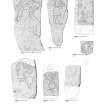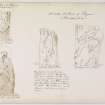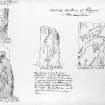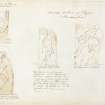Following the launch of trove.scot in February 2025 we are now planning the retiral of some of our webservices. Canmore will be switched off on 24th June 2025. Information about the closure can be found on the HES website: Retiral of HES web services | Historic Environment Scotland
Rhynie
Pictish Symbol Stone (Pictish)
Site Name Rhynie
Classification Pictish Symbol Stone (Pictish)
Alternative Name(s) Rhynie, Plough Inn; Rhynie No. 3
Canmore ID 17185
Site Number NJ42NE 22.02
NGR NJ 4980 2715
NGR Description Removed from NJ 4985 2702
Datum OSGB36 - NGR
Permalink http://canmore.org.uk/site/17185
- Council Aberdeenshire
- Parish Rhynie
- Former Region Grampian
- Former District Gordon
- Former County Aberdeenshire
Rhynie 3, Aberdeenshire, Pictish symbol stone
Measurements: H c 1.35m, W 0.58m
Stone type: whinstone
Place of discovery: NJ 4985 2702
Present location: beside the gate at the north end of the square.
Evidence for discovery: found during roadworks around 1836 near the Plough Inn at Rhynie and placed near Howies Inn. In 1864 it was taken to the market square.
Present condition: very weathered.
Description
One broad face bears traces of the incised figure of a man with a small square shield and a spear with a knobbed terminal above two overlapping double arcs.
Date: seventh century.
References: ECMS pt 3, 182, no 3; Fraser 2008, no 43.3.
Desk-based information compiled by A Ritchie 2017
Field Visit (6 May 1996)
NJ42NE 22.02 4980 2715 (removed from 4985 2702)
A pair of small stones (NJ42NE 22.01 and 22.02) flank the NW gate of Rhynie Square. That to the W of the gate is a granite boulder measuring 0.55m in breadth by 0.31m in thickness and 0.9m in height; on its SE face it bears the incised figure of a man carrying a spear and a rectangular shield. The stone is very worn and areas of the surface have flaked off. The only surviving portions of the design are: the line of the back of the head and shoulders; the lower legs and feet; the right hand holding the spear, which terminates in a circular knob; the lower portion of the rectangular shield; a faint line indicating the upper edge of the shield; and a line between the figure and the spear, terminating in a circle of uncertain significance. A line running diagonally across the legs, which is depicted by Logan in 1825, does not appear to be part of the original carving. A curved feature below the feet of the figure, however, appears to correspond with the upper edge of a circular object depicted by Logan.
Visited by RCAHMS (IF, JRS), 6 May 1996.
Photogrammetric Survey (29 August 2014 - 31 August 2014)
NJ 49933 26490, NJ 4980 2715 and NJ 49749 26345 The ACCORD (Archaeology Community Co-production Of Research Data) Project was an Arts and Humanities Research Council (AHRC) funded research project led by the Digital Design Studio (Glasgow School of Art), with the University of Manchester, RCAHMS and Archaeology Scotland, which worked with 10 community groups across Scotland from October 2013 to March 2015. The project aimed to co-design and co-produce 3D digital data of heritage sites that are of significance to the community groups and which they wished to record.
The ACCORD team worked with the Rhynie Woman group based in Rhynie and Huntly, from 29–31 August 2014. Together we modelled and recorded a standing stone with Pictish symbols known as the ‘Craw Stane’, another Pictish symbol stone in the town square and two headstones in the Rhynie churchyard, one 18th-century and the other 19th- century in date. We used the techniques of photogrammetry and Reflectance Transformation Imaging.
Archive: ADS and National Record of the Historic Environment (NRHE)
Funder: Arts and Humanities Research Council
Stuart Jeffrey and Mhairi Maxwell – Glasgow School of Art
(Source: DES, Volume 16)
Note (May 2017)
Discovering a Lost People
Modern day Rhynie is a rural village in central Aberdeenshire, surrounded by open countryside. It is a picturesque location, and deceptively modest, for archaeological evidence attests to many centuries of high status settlement in the area. Even the name Rhynie itself is regal, deriving from 'Rig' meaning King. Many Pictish stones have been found here, including the famous 'Rhynie Man', a 6ft high figure carrying an axe, found in a field in 1978.
So who were the Picts, and what were they doing at Rhynie? These are the very questions which are currently being investigated by The University of Aberdeen's Northern Picts project. The project aims to find the Picts in the landscape of Northern Scotland, and has had many notable successes in recent years. The Rhynie Environs Archaeology Project (REAP) is a key case study within the Northern Picts project. It is a collaborative endeavor between the Universities of Aberdeen, Chester and Glasgow and the local community artist collective Rhynie Woman.
Excavations in 2011 and 2012 revealed a series of fortified enclosures near to the the Craw Stane, a Class I Pictish symbol stone which still stands today. This is located at Barflat, northwest of the present day village and very close to where Rhynie Man was found in the 1970s. Early indications were that this was an important settlement. Further work revealed a series of concentric enclosures centred on a ring ditch and other possible timber structures, and in association with the Class I symbol stone. An interpretative reconstruction of the site has recently been completed and it is available to view online. You can access it by clicking on the link below.
Settlement evidence for this period is very rare, and the evidence for Pictish buildings which has been found at Rhynie is extremely important. Equally significant is the evidence for large-scale high status metalworking at the site, and a range of Continental imports which have been found here, indicating without doubt that Rhynie was an important power centre dating from the 4th to the 6th centuries AD. A contemporary cemetery has been found closer to the village.
Contextualising Rhynie / Moulds and Metal
The Rhynie Environs Archaeology Project is investigating the interaction between the high status site here and the wider landscape. The complex at Barflat is close to two small fortified sites at Cairnmore and Wheedlemont, and the great hillfort at Tap O'Noth [see previous Archaeology InSites feature under Age of Iron]. A 5th/6th century phase has been identified at Cairnmore and it is very likely that both Wheedlemont and Tap were in use at this time, but connections between these sites and Rhynie are still to be established. Understanding the links between these sites, and indeed if they are there at all, is key to understanding the development and control of the landscape of the Strathbogie area.
Rhynie has yielded a rich assemblage of high status material. One of the most iconic finds from the site is the axe shaped pin which was found in 2012. This pin, with its serpent design, resembles the axe which is carried by Rhynie Man, now in the reception area of Woodhill House, the headquarters of Aberdeenshire Council. The 2016 excavations revealed the best evidence yet for high status metalworking at Rhynie. Over 50 sherds of crucibles were found at the site, and clay moulds were uncovered in greater numbers than at any other known Pictish site. These moulds produced a range of different pins and brooches. There was even evidence for enameling. The finds from the 2016 season are currently undergoing conservation work, and although less visually striking than the finished products, they have the potential to tell us far more.
Dr Kirsty Owen - Archaeology and World Heritage Team
Excavation (30 July 2018)
NJ 4985 2702 In July 2018 SMC was granted to open a small test pit around Rhynie No.3 measuring c.1 x 1 m and 0.3 m deep to expose the possible symbol carvings at the base of the human figure. The trench was opened by hand using a spade with plastic tools used in the immediate vicinity of the carved face on the southwest side of the stone to minimize any chances of damage. Soft brushes were used to remove any remaining soil around the face of the stone to allow recording of the stone face using digital recording techniques. These techniques included conventional digital SLR photography and photogrammetry. The digital recording revealed new detail regarding the human figure and a possible symbol below their feet.
Gordon Noble and James O'Driscoll - University of Aberdeen
Report will appear in Discovery and Excavation, Volume 20, 2019.




























